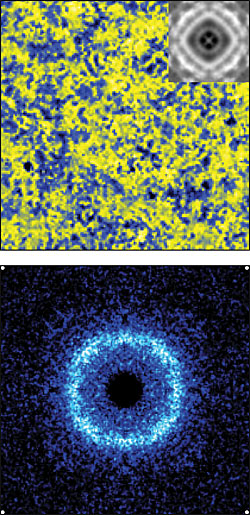Impurity Atoms Introduce Waves of Disorder in Exotic Electronic Material
Sophisticated electron-imaging technique reveals widespread “destruction,” offering clues to how material works
October 17, 2011
UPTON, NY — It’s a basic technique learned early, maybe even before kindergarten: Pulling things apart — from toy cars to complicated electronic materials — can reveal a lot about how they work. “That’s one way physicists study the things that they love; they do it by destroying them,” said Séamus Davis, a physicist at the U.S. Department of Energy’s (DOE) Brookhaven National Laboratory and the J.G. White Distinguished Professor of Physical Sciences at Cornell University.
 enlarge
enlarge
Top: Visualization of nanoscale disruptions in electron interactions in a Kondo-hole doped heavy-fermion compound. The black-and-white inset shows directly how oscillations in electron behavior are centered on the Thorium impurities, "rippling" outward like disturbances caused by drops of water on a still pond. The rippling oscillations in electron energy are shown in more detail in the close-up view (bottom), where the bands of different shades of blue represent the distance between the ripples.
Davis and colleagues recently turned this destructive approach — and a sophisticated tool for “seeing” the effects — on a material they’ve been studying for its own intrinsic beauty, and for the clues it may offer about superconductivity, the ability of some materials to carry electric current with no resistance. The findings, published in the Proceedings of the National Academy of Sciences the week of October 17, 2011, reveal how substituting just a few atoms can cause widespread disruption of the delicate interactions that give the material its unique properties, including superconductivity.
The material, a compound of uranium, ruthenium, and silicon, is known as a “heavy-fermion” system. “It’s a system where the electrons zooming through the material stop periodically to interact with electrons localized on the uranium atoms that make up the lattice, or framework of the crystal,” Davis said. These stop-and-go magnetic interactions slow down the electrons, making them appear as if they’ve taken on extra mass, but also contribute to the material’s superconductivity.
In 2010, Davis and a group of collaborators visualized these heavy fermions for the first time using a technique developed by Davis, known as spectroscopic imaging scanning tunneling microscopy (SI-STM), which measures the wavelength of electrons of the material in relation to their energy.
The idea of the present study was to “destroy” the heavy fermion system by substituting thorium for some of the uranium atoms. Thorium, unlike uranium, is non-magnetic, so in theory, the electrons should be able to move freely around the thorium atoms, instead of stopping for the brief magnetic encounters they have at each uranium atom. These areas where the electrons should flow freely are known as “Kondo holes,” named for the physicist who first described the scattering of conductive electrons due to magnetic impurities.
Free-flowing electrons might sound like a good thing if you want a material that can carry current with no resistance. But Kondo holes turn out to be quite destructive to superconductivity. By visualizing the behavior of electrons around Kondo holes for the first time, Davis’ current research helps to explain why.
“There have been beautiful theories that predict the effects of Kondo holes, but no one knew how to look at the behavior of the electrons, until now,” Davis said.
Working with thorium-doped samples made by physicist Graeme Luke at McMaster University in Ontario, Davis’ team used SI-STM to visualize the electron behavior.
“First we identified the sites of the thorium atoms in the lattice, then we looked at the quantum mechanical wave functions of the electrons surrounding those sites,” Davis said.
The SI-STM measurements bore out many of the theoretical predictions, including the idea proposed just last year by physicist Dirk Morr of the University of Illinois that the electron waves would oscillate wildly around the Kondo holes, like ocean waves hitting a lighthouse.
“Our measurements revealed waves of disturbance in the ‘quantum glue’ holding the heavy fermions together,” Davis said.
So, by destroying the heavy fermions — which must pair up for the material to act as a superconductor — the Kondo holes disrupt the material’s superconductivity.
Davis’ visualization technique also reveals how just a few Kondo holes can cause such widespread destruction: “The waves of disturbance surrounding each thorium atom are like the ripples that emanate from raindrops suddenly hitting a still pond on a calm day,” he said. “And like those ripples, the electronic disturbances travel out quite a distance, interacting with one another. So it takes a tiny number of these impurities to make a lot of disorder.”
What the scientists learn by studying the exotic heavy fermion system may also pertain to the mechanism of other superconductors that can operate at warmer temperatures.
“The interactions in high-temperature superconductors are horribly complicated,” Davis said. “But understanding the magnetic mechanism that leads to pairing in heavy fermion superconductors — and how it can so easily be disrupted — may offer clues to how similar magnetic interactions might contribute to superconductivity in other materials.”
This research was supported by the DOE’s Office of Science, the Natural Sciences and Engineering Research Council of Canada, and the Canadian Institute for Advanced Research. Additional collaborators included Mohammad Hamidian and Ines Firmo of Brookhaven Lab and Cornell, and Andy Schmidt now at the University of California, Berkeley.
2011-11335 | INT/EXT | Newsroom









